Tips for spotting fake sourdough bread at the store so you don’t waste your money on a phony product that is an unhealthy choice.
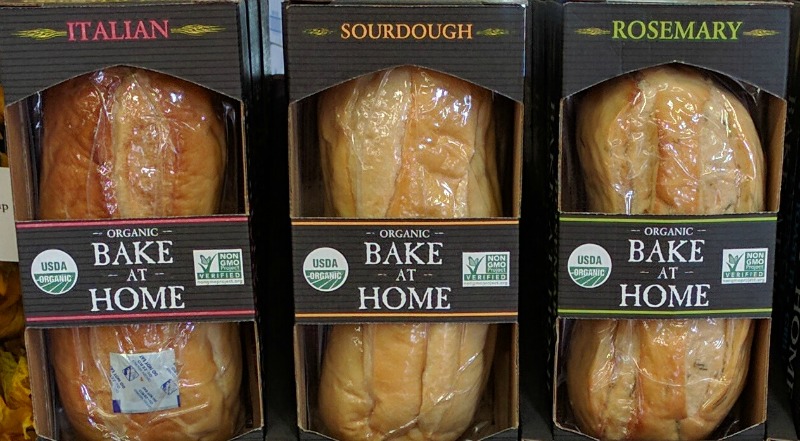
As awareness of the benefits of sourdough bread increases, so does the potential for food manufacturers – both large and small – to exploit the term.
And exploit it they most certainly do!
I recently examined every single loaf of bread at a local health food store. I found only one out of over half a dozen that claimed to be “sourdough” that was leavened in a traditional manner. No, it wasn’t The Essential Baking Company sourdough bread in the picture above. You won’t believe what this company is doing to fool consumers. Even I was shocked, and I thought I had seen it all.
If you choose to buy instead of making sourdough bread yourself (yes, it is a bit time-consuming!), then be on the lookout for fake sourdough!
It is literally everywhere!
Spotting phony sourdough is a more difficult process than you might think due in part to the sourdough myths that seem to abound.
When I first set out to write this article, I thought it would be fairly straightforward to explain. As it turns out, spotting a fake sourdough is rather tricky due to unethical food manufacturer tactics that are far sneakier and devious than I ever imagined.
You really need to be on your toes when sourcing sourdough bread to ensure that you aren’t wasting your money on a product you thought was a healthy choice for your family, but in fact, was quite the opposite.
If you use reading glasses, be sure to always bring a pair with you into the store so you can read the fine print on the packaging. If you wait until you get home to take a look, chances are you are going to be disappointed.
Fake Sourdough Masquerading as Real
The picture above shows one of the most popular fake sourdoughs on the market as of this writing. I was asked to take a look at it by a reader who thought it was legit. This brand is available at many health food stores. At my local Whole Foods, it is very prominently placed with an attractive display right near the checkout lines.
Some folks have notified me that it is also available at Sam’s Club and Walmart mega-supermarkets too!
Notice how the company has taken great care to appeal in every way to the health-conscious, time-challenged consumers:
- The loaf is clearly labeled “Sourdough”.
- The USDA Organic certification is front and center on the box.
- The NonGMO Verified label is prominently shown.
- The term “Bake at Home” is used to catch the eye of time-strapped consumers, some of whom WANT to provide fresh-baked sourdough for their family, but just don’t have the time.
I give this label a 10 out of 10. Fantastic marketing that is sure to move those boxes off the shelf like hotcakes. It’s even priced like a real sourdough would be at $6+/loaf where I live.
Watch Out for Ingredients Listed on the Box vs Online
Here’s the sneaky part. The ingredients on the label of this phony sourdough are DIFFERENT than what is on the website. Yes, the company has obviously done its research. Consumers are increasingly checking out products online before buying.
Don’t fall for this trick. Below is an online screengrab from December 28, 2016, of the ingredients for this company’s “sourdough” bread:
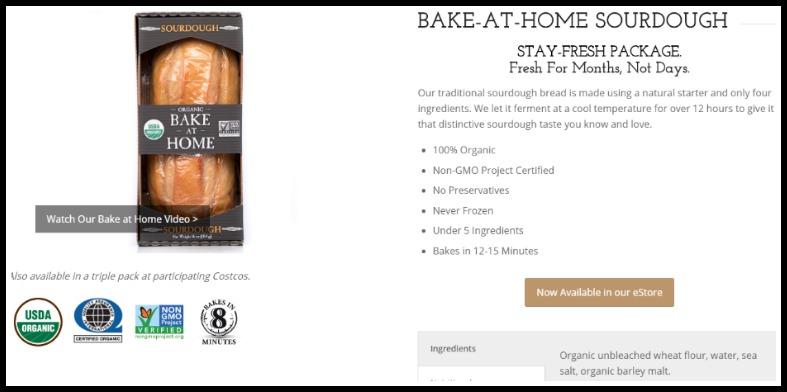
Notice the ingredients say: organic unbleached wheat flour, water, sea salt, organic barley malt.
To semi-researched consumers who know enough about sourdough bread to understand that it never contains yeast, this is enough information to fool them and get them to buy.
Take care not to be easily fooled, however! Look what I found when I looked at the actual label of this very same sourdough bread at the store. Check out the photo below taken on the very same date – December 28, 2016.
The exact same sourdough bread has YEAST listed on the box!
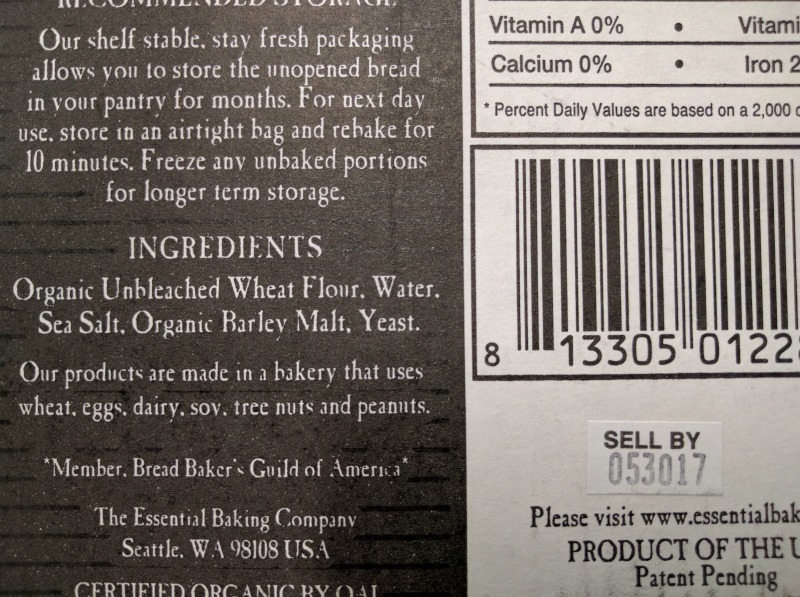
This is a new tactic I have not been aware of before … listing different ingredients for a product online versus what is on the label. Online it states “under five ingredients” using a “natural starter” with the bread “fermented” at a cool temperature for over 12 hours. The box at the store, however, lists 5 ingredients and the “natural starter” turns out to be yeast, which is most decidedly unnatural when it comes to sourdough! Other problems with this bread include the use of sweetener (organic barley malt) and white flour.
If a product seems too good to be true, it probably is.
I mean, seriously? Would an authentic sourdough come in a convenient “bake at home in 12-15 minutes” package that is shelf-stable for nearly 6 months?
Absolutely not!
The short video below summarizes the issues and how to spot the good stuff.
Authentic Labels
The label of true sourdough bread is going to list sourdough starter instead of yeast in the list of ingredients. For example, the gluten-free sourdough bread I buy from a local bakery has “cultured brown rice flour” listed as the starter.
The wording for the sourdough starter varies from brand to brand.
However, there will usually be some indication of a cultured starter as the leavening agent.
This starter contains natural beneficial yeasts from the environment rather than processed baker’s yeast which increases baking speed and baking temperature.
This is important because naturally leavened bread is more digestible, nutritious and less likely to trigger allergy problems than modern, yeast rise bread.
Ultimately, the consumer really must take the time to ensure that the sourdough bread of their choosing really is what it claims.
The Sourdough Bread I Buy
Real sourdough bread is so difficult to find that I’ve resorted to shipping freshly baked sourdough direct from the bakery to my door.
The bakery I use is Organic Bread of Heaven and I order the Rustic Sourdough. I ship in six loaves at a time and freeze what I won’t use in 4-5 days. They also have sourdough bagels, tortillas, hamburger buns, and English muffins among other authentic items.
Free shipping is available for orders over $49 (ask a friend to jump in with you!). The price is several dollars cheaper per loaf than the bread at the health food store.
To give it a try, use coupon HEALTHYHOME (all caps) for 10% off your first order.
Even if you pay shipping by ordering just a few real sourdough loaves, the price per loaf is still comparable to the fake sourdough at the health food store!
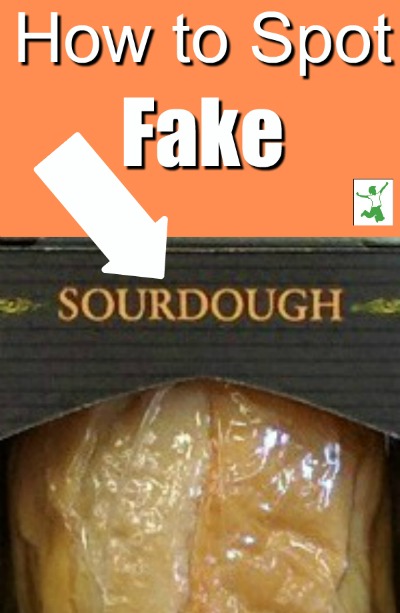
Rules of Thumb
Here are some rules of thumb to identify authentic sourdough bread:
- A handful of ingredients
- No yeast
- Cultured flour starter
- No sweetener
- Made using whole grain flour
- The dough ferments before baking for at least 4-6 hours
After examining the label, if you are still unsure, make a phone call or email to the company. Ask how long the sourdough is allowed to rise (double in size) before baking.
A true sourdough is going to rise for a minimum of about 4-6 hours and even as long as 10-15 hours depending on the temperature.
No baker’s yeast is needed. In addition, no sweetener should appear on the label.
Fake Sourdough At Panera
Be aware that Panera markets its sourdough as real when it is fake too.
Longtime reader Beth S. sent me this email from Panera customer support when she inquired about the authenticity of its sourdough bread. Beth gave her permission to reprint this email.
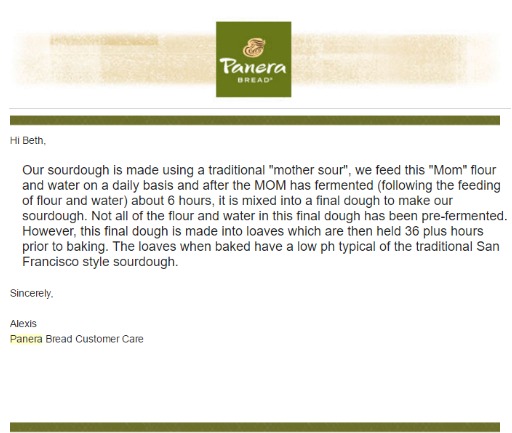
While this answer sounds promising, examining the ingredients of Panera Bread’s sourdough quickly identifies it as a fake. From the Panera website:
Unbleached Enriched Wheat Flour (Flour, Malted Barley Flour, Niacin, Reduced Iron, Thiamine Mononitrate, Riboflavin, [synthetic] Folic Acid), Water, Salt, Yeast (Yeast, Sorbitan Monostearate, Ascorbic Acid [GMO]), Dough Conditioner (Ascorbic Acid [GMO], Microcrystalline Cellulose [refined wood pulp], Corn Starch [GMO])
Not only is the Panera sourdough a phony, but it also contains yeast, wood pulp, and GMOs. It is also fortified with synthetic vitamins including dangerous folic acid (instead of natural folate).
At least The Essential Baking Company’s fake sourdough described earlier in this article is organic. This means no GMOs or other toxic ingredients.
As you can see, the phony sourdoughs on the market today range from simply misleading to downright dangerous. Best to avoid them all and get the real thing!
Do you currently buy an authentic sourdough? If so, what are the ingredients and what is the brand?
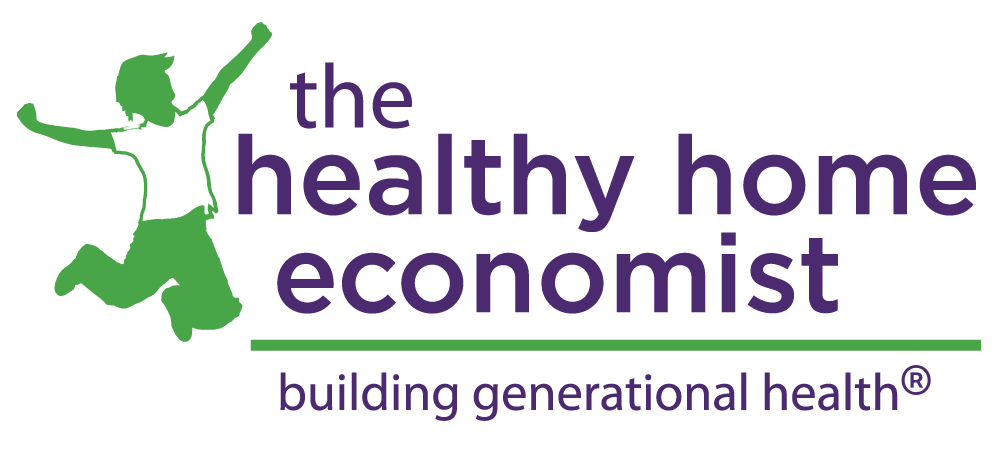







There is a bakery in Colorado Springs called the sourdough Boulangerie. The baker makes each loaf by hand the traditional way and uses all local organic ingredients. The only sourdough I buy when I don’t make my own! 🙂
My only question to you is in this article you state, (last line in the paragraph right under the ingredients on the label), “Other problems with this bread include the use of sweetener (organic barley malt) and white flour.” But I don’t see white flour listed as an ingredient in that bread…not listed on the box nor on their website. ? So I am unclear as to what you mean by ‘white flour’. Thanks so much.
Hi JoAnn, if you look at the label on the website or the box, there is less than 1 gram per serving (<1) in this bread indicating that although unbleached, all the bran has been removed ... this is white bread made from refined flour. And, given that this bread is yeasted, it is one step above plain sugar as it a refined carbs product 🙁
“One Love Bread” made in Withee, Wisconsin! Love it! Check out their website.
Luck for us, we have a local company based out of Atascadero, California called Brian’s Artisan Bread. They make fresh sourdough daily the old fashioned way, and you sure can taste the difference!
briansartisanbread.com/
Yes you can definitely taste the difference when you eat a true sourdough for the first time! 🙂
How did you order the Weston Price shopping guide?
You can order on the website (westonaprice.org) or call the Foundation directly and have it mailed to you.
I was really astonished to find that in my area there are several stores that actually carry true sourdough breads! The Thrive Market health foods store located about 30 miles from me carries a number of “sourdough” breads—none of which are actual sourdough. Most phony “sourdough” breads that I have seen will also list vinegar as an ingredient!
Thank you so much for bringing this to the light! I am allergic to yeast, so I read every “sourdough” label carefully. I have been shocked how many manufacturers use yeast in what they claim to be sour dough. I actually buy my breads from a local bakery in another town (I have to stock up and freeze because it’s a 2 hour drive to the other town), but am always on the lookout for a real sourdough in my town. Shouldn’t be hard in a big city like Phoenix – but unfortunately it is.
I grind my own wheat and make sour dough bread, but I do put some yeast in it. What is the problem with using some yeast? I like the mild sour flavor.
The yeast is an easier and more convenient way to get the bread to rise so is preferred by modern bakers, but traditional sourdough ferments the dough without yeast using a probiotic culture instead which breaks down anti-nutrients, gluten and some of the difficult to digest carbs. It is MUCH harder on digestion over the long haul eating modern yeasted breads and contributes to chronic disease. Traditional societies that ate bread never used yeast .. only a natural probiotic starter. If you click over to the sourdough myths article linked to in the post, a historical rundown of when yeast came into play is described. Use of yeast making bread is a big reason why people are having so much trouble with bread today and why it is (rightly) perceived to be unhealthy. Traditional sourdough made without yeast is a different food entirely. But, when you eat it you don’t get this compulsive addictive reaction to it …you eat a little bit and you are full. Yeasted breads that are sweetened on top of it are addictive and easy/faster to make which is why people prefer them.
Wait…. Sarah…. You do know that sourdough starter contains yeast, right? That’s what makes the bread rise? The yeast in the starter ingests the carbs from the flour and releases carbon dioxide which creates the pockets in the dough?? Come on…
There’s a big difference between the living yeasts and beneficial flora in a sourdough culture that actually break down gluten and carbs during fermentation and dead baker’s yeast that simply puffs up the loaf for a quick rise in the oven. Important to be able to discern the nuances 🙂
Yeast IS a probiotic! Oy…
Sad to hear about Panera… So, what are some good and “Real” bread choices out there??
I know … can you believe Panera uses dough conditioner with wood pulp in it. I mean, talk about cheap. I recommend the Weston Price Foundation Shopping Guide for a full list of REAL sourdough breads. I just got my 2017 guide in the mail yesterday and there are over 25 bread brands listed in the “Best” category alone with another 25+ in the “Good” category.
This makes me angry about Essential Baking Company! I noticed it too the other day when looking at the ingredients at a local QFC market for a single loaf, however, the 3-packs they sell at Costco do not list yeast as an ingredient. Just the flour, water, salt and barley malt. So either they recently changed it and there’s still some of the old ones in circulation at Costco or they are intentionally (possibly illegally?) putting erroneous ingredient information on some of their products. Either way, I’ll no longer be purchasing their bread. Thank you for pointing this out!
The sugar (barley malt) is a hint that yeast is being used in a sourdough bread even if not so labeled. I’ve been skeptical of this brand for a long time for this reason (I had only checked on the website before). Glad to finally out them about what they are doing when I had that lightbulb moment to check the box too.
It’s so sad that even companies putting out an organic product are starting to use the same deceptive labeling practices as large food manufacturers (who have deceptive marketing down to a science particularly when it comes to hiding MSG on labels!). I find this nothing short of DISTURBING because those who are gluten or grain intolerant MUST eat ONLY a traditional sourdough else they risk a negative health reaction!